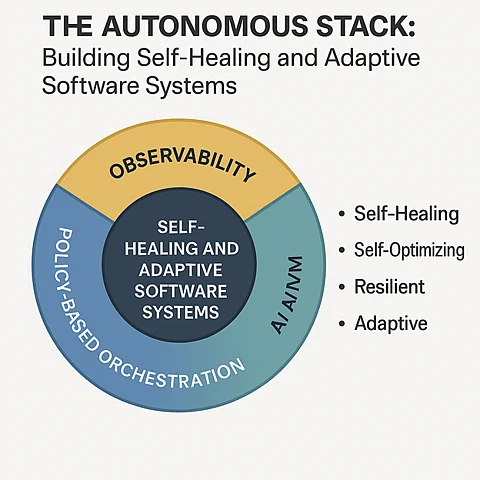Technology
Revolutionizing Software Management with the Autonomous Stack

The complexity of modern software environments demands innovative operational strategies, particularly those that span cloud, edge, and artificial intelligence infrastructures. According to Naga V K Abhinav Vedanbhatla, the concept of the Autonomous Stack represents a significant advancement in system design, enabling software systems to self-heal, optimize, and adapt autonomously. This architecture relies on observability, artificial intelligence (AI), machine learning (ML), event-driven patterns, and policy-based orchestration, allowing systems to respond to faults without requiring human intervention.
Understanding the Autonomous Stack
The evolution of microservices, containers, and AI has created intricate distributed environments that challenge traditional management techniques. Manual oversight proves inadequate as these systems scale. The Autonomous Stack addresses these challenges by embedding intelligence directly into the operational core. By utilizing real-time observability, service meshes for communication control, and machine learning for decision-making, these systems enhance automation and responsiveness. They align with contemporary practices such as DevOps and AIOps, offering scalable resilience and continuous optimization essential for dynamic software environments.
Historically, system reliability has relied on human-administered responses and static rules. While observability tools have improved system visibility, they often fail to detect complex anomalies before they disrupt operations. The Autonomous Stack shifts this paradigm by incorporating AI and ML principles, enabling systems to proactively identify and address performance issues. This transition marks a significant evolution, as systems evolve from passive observers to active participants in their maintenance and optimization.
Research Insights and Practical Applications
In this study, qualitative methods were employed to analyze widely adopted platforms such as Kubernetes, Keptn, and Istio. These tools were assessed for their autonomous capabilities, particularly in fault recovery, performance enhancement, and latency reduction. Case studies involving Netflix and Alibaba illustrate the practical applications of these models, highlighting the implementation of observability and automation in production environments through technologies like Prometheus, Argo Rollouts, and OpenTelemetry.
Observability serves as the backbone of the Autonomous Stack. Various tools, from Prometheus to OpenTelemetry, gather real-time telemetry data, feeding into feedback loops and AI-driven models. Service meshes like Istio and Linkerd facilitate dynamic control over internal communications, featuring capabilities such as fine-grained traffic shaping and fault tolerance. AI and ML components enhance predictive capabilities, including failure predictions and auto-scaling, orchestrating system responses based on operational goals.
The deployment of autonomous systems is exemplified by Netflix, which utilizes Conductor for event-driven workflows and ML-based traffic rerouting to manage low-availability events during peak stress. Tools like Chaos Monkey are employed to introduce failures deliberately, testing the system’s self-recovery capabilities. Kubernetes, integrated with Argo Rollouts and Prometheus, demonstrates the effective combination of declarative deployment strategies and real-time monitoring, minimizing risks associated with performance degradation. Automatic rollbacks occur within minutes, ensuring stability without human oversight.
Keptn further enhances this concept by implementing Service Level Objective (SLO)-based orchestration. It integrates with observability tools to monitor system health and initiate remediation workflows when service quality declines, guaranteeing runtime healing and operational assurance.
Experimental evidence showcases the remarkable benefits of autonomous deployment practices. Systems running on Kubernetes with Argo Rollouts achieved rollback times of under two minutes during fault events, significantly reducing downtime. Keptn’s automation has increased deployment success rates by 15% through proactive remediation. Netflix reported a 25% increase in system throughput and a 20% reduction in latency during high-demand scenarios. Overall, deployment frequency improved by up to 30%, while mean time to recovery (MTTR) decreased by 40%, highlighting how intelligent systems minimize human error and maintain high availability.
Looking ahead, embracing full autonomy in system management will require careful planning. Organizations must prioritize robust telemetry, establish health thresholds, and continuously upgrade machine learning models. Challenges may arise, such as model maintenance issues or false triggers, which could lead to overcorrection. Nevertheless, the benefits in terms of resilience, speed, and flexibility are substantial. Future developments will likely focus on deeper AI integrations, multi-cloud orchestrations, and the human factors that influence successful adoption.
The Autonomous Stack does not diminish the role of human oversight; rather, it enables teams to focus on innovation instead of reactive problem-solving.
In conclusion, the exploration of platforms like Kubernetes, Netflix Conductor, and Keptn emphasizes the transformative potential of autonomous software systems. Their intelligent designs and self-regulating mechanisms facilitate quicker, safer, and more reliable software delivery. This shift fundamentally alters how distributed systems are designed and maintained, with implications for observability, policy orchestration, and ML-driven decision-making. As the demand for scalable, fault-tolerant infrastructure grows, the Autonomous Stack emerges as a vital model for the future of DevOps and cloud-native operations.
-

 Technology5 months ago
Technology5 months agoDiscover the Top 10 Calorie Counting Apps of 2025
-

 Health2 months ago
Health2 months agoBella Hadid Shares Health Update After Treatment for Lyme Disease
-

 Health3 months ago
Health3 months agoErin Bates Shares Recovery Update Following Sepsis Complications
-

 Technology4 months ago
Technology4 months agoDiscover How to Reverse Image Search Using ChatGPT Effortlessly
-

 Technology1 month ago
Technology1 month agoDiscover 2025’s Top GPUs for Exceptional 4K Gaming Performance
-

 Technology2 months ago
Technology2 months agoElectric Moto Influencer Surronster Arrested in Tijuana
-

 Technology5 months ago
Technology5 months agoMeta Initiates $60B AI Data Center Expansion, Starting in Ohio
-

 Technology5 months ago
Technology5 months agoRecovering a Suspended TikTok Account: A Step-by-Step Guide
-

 Health4 months ago
Health4 months agoTested: Rab Firewall Mountain Jacket Survives Harsh Conditions
-

 Lifestyle5 months ago
Lifestyle5 months agoBelton Family Reunites After Daughter Survives Hill Country Floods
-

 Technology4 months ago
Technology4 months agoHarmonic Launches AI Chatbot App to Transform Mathematical Reasoning
-

 Technology3 months ago
Technology3 months agoUncovering the Top Five Most Challenging Motorcycles to Ride





















